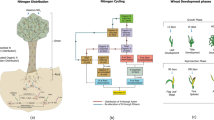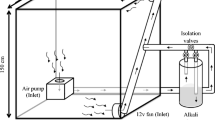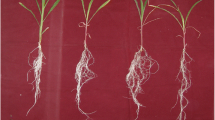Abstract
The carbon and nitrogen partitioning characteristics of wheat (Triticum aestivum L.) and maize (Zea mays L.) grown hydroponically at a constant pH on either 4 mM or 12 mM NO3 - or NH4 + nutrition were investigated using either 14C or 15N techniques. Greater allocation of 14C to amino-N fractions occurred at the expense of allocation of 14C to carbohydrate fractions in NH4 +-compared to NO3 --fed plants. The [14C]carbohydrate:[14C]amino-N ratios were 1.5-fold and 2.0-fold greater in shoots and roots respectively of 12 mM NO3 --compared to 12 mM NH4 +-fed wheat. In both 4 mM and 12 mM N-fed maize the [14C]carbohydrate:[14C]amino-N ratios were approximately 1.7-fold and 2.0-fold greater in shoots and roots respectively of NO3 --compared to NH4 +-fed plants. Similar results were observed in roots of wheat and maize grown in split-root culture with one root-half in NO3 --and the other in NH4 +-containing nutrient media. Thus the allocation of carbon to the amino-N fractions occurred at the expense of carbohydrate fractions, particularly within the root. Allocation of 14N and 15N within separate sets of plants confirmed that NH4 --fed plants accumulated more amino-N compounds than NO3 --fed plants. Wheat roots supplied with 15NH4 + for 8 h were found to accumulate 15NH4 + (8.5 μg 15N g-1 h-1) whereas in maize roots very little 15NH4 + accumulated (1.5 μg 15N g-1 h-1)
It is proposed that the observed accumulation of 15NH4 + in wheat roots in these experiments is the result of limited availability of carbon within the roots of the wheat plants for the detoxification of NH4 +, in contrast to the situation in maize. Higher photosynthetic capacity and lower shoot: root ratios of the C4 maize plants ensure greater carbon availability to the root than in the C3 wheat plants. These differences in carbon and nitrogen partitioning between NO3 --and NH4 +-fed wheat and maize could be responsible for different responses of wheat and maize root growth to NO3 - and NH4 + nutrition.
Similar content being viewed by others
References
Allen S and Smith J A C 1986 Ammonium nutrition in Ricinus communis: Its effect on plant growth and the chemical composition of the whole plant, xylem and phloem saps. J. Exp. Bot. 37, 1599–1610.
Atkins C A and Canvin D T 1971 Photosynthesis and CO2 evolution by leaf discs; gas exchange, extraction, and ion-exchange fractionation of 14C-labelled photosynthetic products. Can. J. Bot. 49, 1225–1234.
Blacquière T, Hofstra R and Stulen I 1987 Ammonium and nitrate nutrition in Plantago lanceolata and Plantago major L. spp. major. I. Aspects of growth-chemical composition and root respiration. Plant and Soil 104, 129–141.
Chaillou S, Vessey J K, Morot-Gaudry J-F, Raper Jr C D, Henry L T and Boutin J P 1991 Expression of characteristics of ammonium nutrition as affected by pH of the root medium. J. Exp. Bot. 42, 189–196.
Cooper H D, Clarkson D T, Johnston M G, Whiteway J N and Loughman B C 1986 Cycling of amino-nitrogen between shoots and roots in wheat seedlings. In Fundamental, Ecological and Agricultural Aspects of Nitrogen Metabolism in Higher Plants. Eds. H Lambers, J J Neeteson and I Stulen. pp 97–100. Martinus Nijhoff Publishers, Dordrecht, Boston, Lancaster.
Cooper H D and Clarkson D T 1989 Cycling of aminonitrogen and other nutrients between shoots and roots in cereals — A possible mechanism integrating shoot and root regulation of nutrient uptake. J. Exp. Bot. 40, 753–762.
Cramer M D and Lewis O A M 1993 The influence of NO3 - and NH4 + nutrition on the gas exchange characteristics of the roots of wheat (Triticum aestivum) and maize (Zea mays) plants. Ann. Bot. (In press).
Cramer M D and Lewis O A M 1993 The influence of nitrate and ammonium nutrition on the growth of wheat (Triticum aestivum) and maize (Zea mays) plants. Ann. Bot. (In press).
Faust H 1967 Probenchemie 15N-markierter Stickstoffverbindungen im Mikro-bisnanomolbereich für die Emissionsspektrometrishe Isotopenanalyse. Isotopenpraxis 3, 100–103.
Goyal S S and Huffaker R C 1984 Nitrogen toxicity in plants. In Nitrogen in Crop Production. Ed. R DHauck. pp 97–118. American Society of Agronomy, Crop Science Society of America, Soil Science Society of America, Madison.
Hewitt E J 1966 Sand and water culture methods used in the study of plant nutrition. 2nd revised edition. Common-wealth Bureau of Horticultural and Plantation Crops, East Malling. Technical Communication No. 22, Common-wealth Agricultural Bureau, Farnham Royal, England.
Larsson C-M, Larsson M, Purves J V and Clarkson D T 1991 Translocation and cycling through roots of recently absorbed nitrogen and sulphur in wheat (Triticum aestivum) during vegetative and generative growth. Physiol. Plant. 82, 345–352.
Lewis O A M and Chadwick S 1983 An 15N investigation into nitrogen assimilation in hydroponically-grown barley (Hordeum vulgare L. cv. Clipper) in response to nitrate, ammonium and mixed nitrate and ammonium nutrition. New Phytol. 95, 635–646.
Lewis O A M, Fulton B and von Zelewski A A A 1987 Differential distribution of C in response to nitrate ammonium and nitrate + ammonium nutrition in wheat. In Inorganic Nitrogen Metabolism. Eds. W R Ullrich, P J Aparicio, P J Syrett and F Castillo. pp 240–246. Springer-Verlag, Berlin.
Lewis O A M, Leidi E O and Lips S H 1989 Effect of nitrogen source on growth response to salinity stress in maize and wheat. New Phytol. 11, 155–160.
Lewis O A M, Cramer M and Van Der Leij T 1990 Influence of nitrogen source on carbon distribution in plants exhibiting the C3 and C4 photosynthetic pathways. In Inorganic Nitrogen Metabolism in Plants and Microorganisms, Uptake and Metabolism. Eds. W R Ullrich, C Rigano, A Fuggi and P J Aparicio. pp 240–246. Springer-Verlag, Berlin.
Murphy A T and Lewis O A M 1987 Effect of nitrogen feeding source on the supply of nitrogen from root to shoot and the site of nitrogen assimilation in maize (Zea mays L. cv. R201). New Phytol. 107, 327–333.
Platt S G, Plaut Z and Bassham J A 1977 Ammonia regulation of carbon metabolism in photosynthesizing leaf discs. Plant Physiol. 60, 739–472.
Robinson J M and Baysdorfer C 1985 Interrelationships between photosynthetic carbon and nitrogen metabolism in mature soybean leaves and isolated leaf mesophyll cells. In Proceedings of the Eighth Annual Symposium in Plant Physiology. Eds. R L Heath and J Preiss. pp 83–104. American Society of Plant Physiologists, Baltimore.
Simpson R J, Lambers H and Dalling M J 1982 Translocation of nitrogen in a vegetative wheat plant (Triticum aestivum). Physiol. Plant. 56, 11–17.
Zar J H 1984 Biostatistical Analysis, 2nd Edition. Prentice-Hall International Inc., London.
Author information
Authors and Affiliations
Rights and permissions
About this article
Cite this article
Cramer, M.D., Lewis, O.A.M. The influence of NO3 - and NH4 + nutrition on the carbon and nitrogen partitioning characteristics of wheat (Triticum aestivum L.) and maize (Zea mays L.) plants. Plant Soil 154, 289–300 (1993). https://doi.org/10.1007/BF00012534
Received:
Accepted:
Issue Date:
DOI: https://doi.org/10.1007/BF00012534




